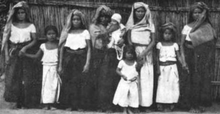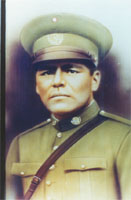

Bën za | |
|---|---|

Picture of Zapotec women and children from 1908
| |
| Total population | |
| c. 400,000-650,000 | |
| Regions with significant populations | |
| Languages | |
| Zapotec, Spanish, English | |
| Religion | |
| Christianity: Roman Catholicism with elements of traditional beliefs |
The Zapotecs (Valley Zapotec: Bën za) are an indigenous people of Mexico. The population is concentrated in the southern stateofOaxaca, but Zapotec communities also exist in neighboring states. The present-day population is estimated at approximately 400,000 to 650,000[1] persons, many of whom are monolingual in one of the native Zapotec languages and dialects. In pre-Columbian times, the Zapotec civilization was one of the highly developed cultures of Mesoamerica, which, among other things, included a system of writing. Many people of Zapotec ancestry have emigrated to the United States over several decades, and they maintain their own social organizations in the Los Angeles and Central Valley areas of California.
There are four basic groups of Zapotecs: the istmeños, who live in the southern Isthmus of Tehuantepec,[2] the serranos, who live in the northern mountains of the Sierra Madre de Oaxaca, the southern Zapotecs, who live in the southern mountains of the Sierra Sur, and the Central Valley Zapotecs, who live in and around the Valley of Oaxaca.
The Zapotecs call themselves Ben 'Zaa, which means "The Cloud People".
For decades it was believed that the exonym name Zapotec came from the Nahuatl tzapotēcah (singular tzapotēcatl), which means "inhabitants of the place of sapote". Recent studies carried out by UNAM indicate that it is actually a hybrid word and should be written Zapochteca or Zaapochteca and comes from “za / zaa” (cloud) and “pochteca” (merchant).[3]

Although several theories of the origin of the Zapotec peoples exist, including some possibly influenced in the post-conquest period, scholars largely agree the Zapotecs inhabited the Central Valley of Oaxaca as early as 500–300 BCE, during what is considered the Monte Alban I period. During this period, the Zapotecs established a significant system of governance over the population of the region. The Monte Alban periods, of which five have been categorized, lasted from 500 BCE to the time of conquest in 1521 AD. Yet archaeological evidence from the site of Monte Alban, "the first city in ancient Mesoamerica"[4] has revealed settlement of the region as far back as 1150 BCE. Scholars have been able to correlate with the Formative, Classic, and post-Classic periods of civilization in the region within the greater Mesoamerican history through these discoveries. The Formative stage, from about 500 BCE to 200 AD of which the periods of Monte Alban I and II are attributed to, is characterized by a shift to sedentary settlements and the practice of agriculture for subsistence. From 200 to 900 AD in the Monte Alban III period, the Classic stage witnessed the rise of social and political structures in the Zapotec civilization. This period also saw a surge in religious activity within the state leadership of the society. Later, during the "Militaristic stage" of Monte Alban IV–V from around 900–1521 AD, a rise in military influence common among Mesoamerican societies led states to become mired in warfare and "cults of war".[5]

The Zapotecan language group is composed of over 60 variants of Zapotecan, as well as the closely related Chatino language. The major variant is Isthmus Zapotec, which is spoken on the Pacific coastal plain of Southern Oaxaca's Isthmus of Tehuantepec.
Though the Zapotecs are now largely Catholics, some of their ancient beliefs and practices, such as the burial of the dead with valuables, still survive. Some images of local Catholic saints resemble the old gods of the Zapotecs. One example is of San Pedro who resembles the Zapotec rain god Cocijo.[6] The first missionaries among the Zapotecs were Bartolomé de Olmeda, a Mercedarian, and Juan Díaz, a secular priest, who was killed by the natives in Quechula near Tepeaca for having "overthrown their idols".[7]
Notably, while the Virgen de Guadalupe is a notable Catholic figure in most of Mexico and Latin America, the Virgen de Juquila is a Catholic Marian devotion founded in the town of Santa Catarina Juquila, in the Mexican state of Oaxaca. Many Zapotec Catholic people participate in an annual pilgrimage to visit the statue during festivities lasting from December 7 to December 9.
At the time of the Spanish conquest of the New World, church and state were not separate in Zapotec society. In fact, the Zapotec lord was trained in religious practice as a requirement prior to taking power. There were large temples built called yo hopèe, the house of the vital force, in which the priests performed religious rites. In the spiritual realm the pè, or life force, lived within various natural elements including wind, breath and was believed to be the spirit, or vital force, of all beings. The priests, known as Copa pitào, who were mostly selected from the nobility, were provided their religious training before taking a position among the religious hierarchy. Commoners were also selected and trained to join the priesthood, but they were only allowed to join the lower ranks. The highest position was held by the ouija-tào, great seer, who was likened to the Pope in the Catholic church by Spanish accounts of the sixteenth century.[8] However, the ouija-tào did not live in Monte Alban, but rather in one of the other urban centers of the Zapotecs in the sub-valley area of Mitla. As a polytheistic religion, the Zapotecs attributed several elements of the natural world to their gods. In the religious practice of the Valley Zapotecs, the primary god was Pitao Cozobi who was associated with maize and agriculture. Other gods include, Cocijo the god of rain and lightning (similar to the Toltec god, Tlaloc); Pitao Cozaana the creator of man, animals and the god of ancestors; Pitao Hichaana the goddess of man and animals as well as children, also considered the Mother goddess; Pitao Pezelao god of the underworld, death, and the earth; Copijcha the Sun god and god of war; Pitao Xicala god of love, dreams, and excess.[9]
Zapotec women in the Mexican state of Oaxaca play a variety of social roles in their families and communities. As is true for many other cultures, Zapotec women have historically had a different place in society than men. These roles are in the context of marriage, childbearing, and work. Within them, they make up a vital part of the fabric that is Zapotec Oaxaca.


{{cite book}}: Cite uses deprecated parameter |authors= (help)[full citation needed]
Mann, James Saumarez (1911). "Mexico" . In Chisholm, Hugh (ed.). Encyclopædia Britannica. Vol. 18 (11th ed.). Cambridge University Press. pp. 317–344.
| International |
|
|---|---|
| National |
|
| Other |
|